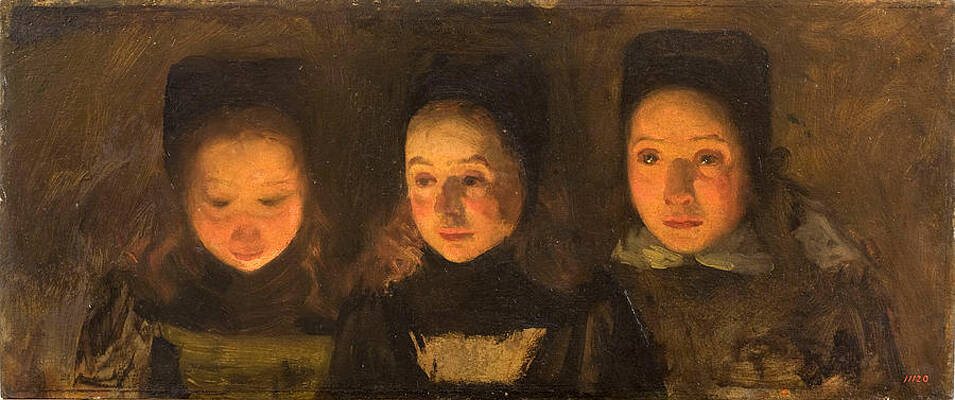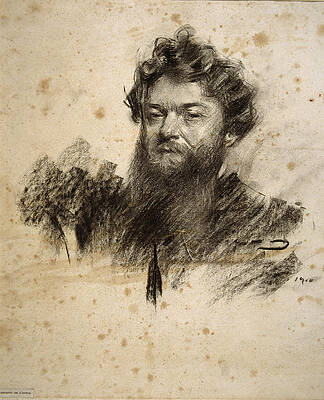Charles Cottet

Trio. Study of Heads
Charles Cottet (1863–1925), French painter, was born at Le Puy-en-Velay and died in Paris. A famed post-impressionist, Cottet is known for his dark, evocative painting of rural Brittany and seascapes. He led a school of painters known as the Bande noire or 'Nubians' group (for the somber palette they used, in contrast to the brighter Impressionist and Postimpressionist paintings), and was friends with such artists as Auguste Rodin.[1]
Biography

Portrait of Charles Cottet, Ramon Casas
Cottet studied at the École des Beaux-Arts, and under Puvis de Chavannes and Roll, while also attending the Académie Julian (where fellow students formed Les Nabis school of painting, with which he was later associated). He travelled and painted in Egypt, Italy, and on Lake Geneva, but he made his name with his sombre and gloomy, firmly designed, severe and impressive scenes of life on the Brittany coast.[2][3][4]
Cottet exhibited at the Salon of 1889, but on a trip to Brittany in 1886 he had found his true calling. For the next twenty years he painted scenes of rural and harbor life, portraying a culture Parisians still found exotic. He is especially noted for his dark seascapes of Breton harbors at dawn, and evocative scenes from the lives of Breton fishermen.[5]
He was close friends with Charles Maurin, and his group included the painter Félix-Émile-Jean Vallotton. Cottet has often been associated with the picturesque seaside symbolism of the Pont-Aven School, though Vallotton famously painted Cottet as a leader of Les Nabis, beside Pierre Bonnard, Édouard Vuillard, and Ker-Xavier Roussel, in his Five Painters (1902-3; Kunstmuseum Winterthur). Cottet was more explicitly the leader of his own small movement, the Bande noire of the 1890s, which included Lucien Simon and André Dauchez, all influenced by the realism and dark colours of Courbet.[6][7][8]
Selected works
Cottet's paintings can be found in museums in France, the Pushkin Museum of Fine Arts in Moscow, the National Gallery of Art in Washington D.C., the Musée d’Orsay in Paris. and at the Hermitage.
1908–09 Au pays de la mer. Douleur also called Les victimes de la mer, the Musée d’Orsay.[9][10]
1905, Petit village au pied de la falaise, Musée Malraux, Le Havre
1900–10, Montagne, Musée Malraux, Le Havre
1896 View of Venice from the Sea, the Hermitage, St. Petersburg.
1896 Seascape with Distant View of Venice, the Hermitage, St. Petersburg.[11]
1896 Portrait de Cottet, the Musée d'Orsay.
See also
"List of the works of Charles Cottet depicting scenes of Brittany"
Notes
Benezit Dictionary of Artists
Chisholm 1911.
Grove Art Online
Art, Famsf, De Young/Legion of Honor
Who was Who on Oxford Index
Grove Art Online, Bande Noire
Springer, "Death at Sea: Symbolism and Charles Cottet’s Subjective Realism"
Rodin Collection
Musée d'Orsay, "Inthe land of grief"
Musée d'Orsay, "Evening light"
Art Hermitage
References
This article incorporates text from a publication now in the public domain: Chisholm, Hugh, ed. (1911). "Cottet, Charles". Encyclopædia Britannica. 7 (11th ed.). Cambridge University Press.
The Grove Dictionary of Art. Macmillan (2000).
----
Fine Art Prints | Greeting Cards | Phone Cases | Lifestyle | Face Masks | Men's , Women' Apparel | Home Decor | jigsaw puzzles | Notebooks | Tapestries | ...
----
Artist
A - B - C - D - E - F - G - H - I - J - K - L - M -
N - O - P - Q - R - S - T - U - V - W - X - Y - Z
Retrieved from "http://en.wikipedia.org/"
All text is available under the terms of the GNU Free Documentation License


